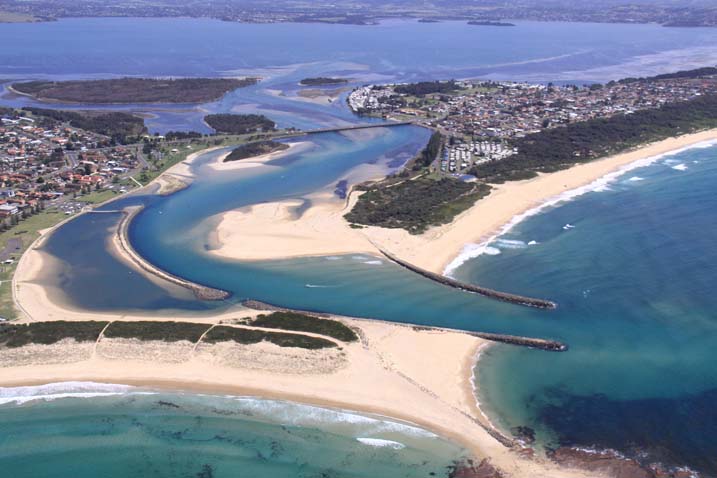Lake Illawarra is located on the south coast of New South Wales near Wollongong. It is classed as a large lake positioned between the Illawarra Escarpment and the sea. The entrances has training walls to ensure the lake remains open to the sea.
Lake Illawarra is valued by local communities for its social, economic and recreational value. This large estuary supports significant tourism and commercial fishing industries, and provides for a wide range of recreational activities.
Water quality report card
As part of our water quality monitoring program we assess the water quality and ecosystem health of an estuary using a range of relevant indicators. We sample a subset of the estuaries between Wollongong and the Victorian border every 3 years. The most recent sampling in Lake Illawarra was completed over the 2023–24 summer, when 2 sites were sampled on a monthly basis.
This report card represents 2 water quality indicators that we routinely measure: the amount of algae present and water clarity. Low levels of these 2 indicators equate with good water quality. The numerical scores for these 2 indicators are averaged to give the overall grade.
Algae
Water clarity
Overall grade
The report card shows the condition of the estuary was good with:
- algae abundance graded excellent (A)
- water clarity graded good (B)
- overall estuary health graded good (B).
Grades for algae, water clarity and overall are represented as:
- A – excellent
- B – good
- C – fair
- D – poor
- E – very poor.
Go to estuary report cards to find out what each grade means, read our sampling, data analysis and reporting protocols, and find out how we calculate these grades.
This table shows water quality grades for the most recent 7 sampling seasons. Previous water quality data is available at NSW Estuary Water Quality Data Compilation: 2007–2020.
| Year | Algae | Water clarity | Overall grade |
|---|---|---|---|
| 2023–24 | A | B | B |
| 2022–23 | A | B | B |
| 2021–22 | A | B | B |
| 2020–21 | A | A | A |
| 2019–20 | B | A | B |
| 2018–19 | A | B | B |
| 2017–18 | A | B | A |
Physical characteristics
| Estuary type | Lake |
|---|---|
| Latitude | –34.54 (ºS) |
| Longitude | 150.88 (ºE) |
| Catchment area | 238.4 km2 |
| Estuary area | 35.8 km2 |
| Estuary volume | 74,275.1 ML |
| Average depth | 2.1 m |
Tidal exchange volume
Tidal prism data is available for this estuary. This tidal prism was measured in 2008.
| Tide state | Flow (ML) | Local tidal range (m) | Sydney Harbour tidal range (m) |
|---|---|---|---|
| Ebb flow | 2,140 | 0.66 | 1.32 |
| Flood flow | 2,700 | 0.63 | 1.32 |
Notes: km2 = square kilometres; m = metres; m3 = cubic metres; ML = megalitres.
Water depth and survey data
Bathymetric and coastal topography data for this estuary are available in our data portal.
Land use
Lake Illawarra estuary is surrounded by urban areas, particularly along the north- and south-eastern shorelines. This includes the townships of Berkeley, Lake Heights, Kanahooka, Oak Flats and Mount Warrigal. Urban areas currently comprise 20% of the catchment. This is likely to increase with extensive urban development planned for the western side of Lake Illawarra.
Grazing is the dominant land use in the catchment at 35%. Large areas of forest (25%) remain along the escarpment at the western boundary, making up about 25% of the catchment.
National and marine parks
- Illawarra Escarpment State Conservation Area and Macquarie Pass National Park protect part of the escarpment along the western catchment boundary.
- This estuary does not flow into a marine park.
Community involvement
- Landcare Illawarra support volunteer groups working to improve the environment in this region.
- There are over 60 bushcare groups in the Wollongong area. Bushcare volunteers help regenerate and care for local bushland.

Aerial view of Lake Illawarra
Local government management
Local councils manage estuaries within their area. Where an estuary is attached to a marine park, marine park management teams are responsible for ensuring compliance with marine park zoning.
Wollongong City Council and Shellharbour City Council manage this estuary.
Threatened species
Lake Illawarra estuary provides habitat for many threatened species, such as the little tern.
Read more about the biodiversity in our estuaries.